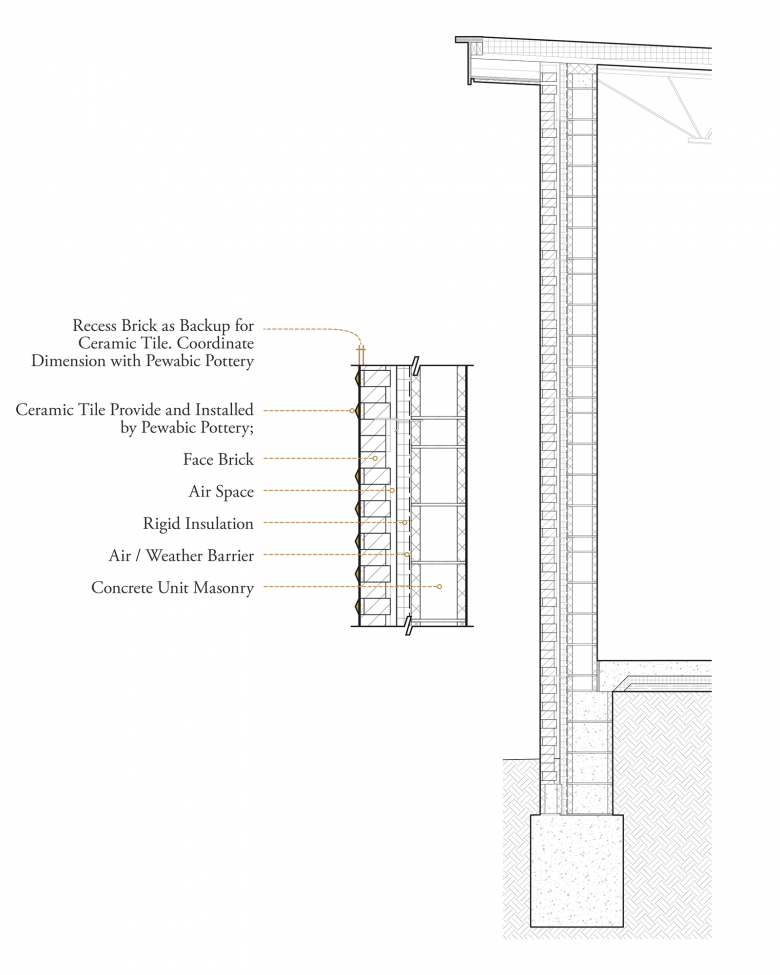U.S. Building of the Week
Pewabic Pottery
INFORM studio
30. junio 2020
Photo: Jason Keen Photography
Although Detroit is known for the manufacturing of automobiles, the city also has a strong tradition of crafts. Pewabic Pottery, established 1903, is an important part of the latter, its glazed tiles adorning many buildings in and beyond Detroit. INFORM studio answered a few questions about their recent addition to Pewabic Pottery's landmark building.
Location: Detroit, Michigan, USA
Client: Pewabic Pottery
Architect: INFORM studio
- Design Principal: Michael Guthrie
- Project Manager: Shannon Schmel
- Project Team: Azubike Ononye, Adam Namespetra, Brian Eady
MEP/FP Engineer: INFORM studio (Steve Kelley, Kelly Sugg)
Contractor: Sachse Construction
Masonry Contractor: James Ross Construction (Masonry Contractor)
Building Area: 2,500 sf (addition)
Existing building with tall chimney made of Pewabic tile with solid glaze
What were the circumstances of receiving the commission for this project?INFORM studio was solicited by the Pewabic Pottery board of directors based on previous reputation of award winning work. Upon a request by the board, INFORM studio was invited to interview and present a design approach for the project. The board selected INFORM studio based on a strategy of reestablishing Pewabic as an institution rooted in innovation.
Photo: Jason Keen Photography
Please provide an overview of the project.Detroit’s historic Pewabic Pottery, a nationally renowned nonprofit design studio and ceramic arts education center founded in 1903, has been handcrafting pottery and architectural tiles for public and private buildings in Detroit and across the U.S. for over a century. Pewabic was previously operating with inefficient space, work spaces not ergonomically designed for employees, and a lack of windows and natural light. These conditions diminish the quality of the visitor experience, making movement and demonstrations difficult.
Photo: Jason Keen Photography
To address these challenges, approximately 2,500 square foot was added to the tile fabrication studio, an addition that more than doubled Pewabic’s current production space, enhanced workflow and efficiency, and improved working conditions for artists while providing a more compelling visitor experience. The addition establishes an open floor plan that allows for a flexible work layout and easy work flow for fabrication, giving fabricators the ability to increase production and efficiency.
Photo: Jason Keen Photography
What are the main ideas and inspirations influencing the design of the building?The exterior façade is designed to highlight Pewabic’s artistry as well as integrate into the fabric of the residential neighborhood. The proportions, texture and street presence were composed to address the surrounding context while still emphasizing the importance of the studio. The use of a white Roman brick brings the craft of clay from the interior to the exterior while continuing the existing palette. The simplicity of a single building material on the exterior was deliberate in order to compliment rather than mimic the historical context. The brick also serves as a canvas against which Pewabic's tiles and the brick pattern are highlighted.
Photo: Jason Keen Photography
How does the design respond to the unique qualities of the site?The addition was designed to stand as a testament of Pewabic’s legacy of craftsmanship; it speaks to its history while gesturing towards their future. Through thoughtful collaboration between the architectural team, the mason and Pewabics' ceramic designers, each team was able to bring experience in their respective disciplines and create a seamlessly integrated product.
Email interview conducted by John Hill.
Photo: Jason Keen Photography
Drawing: INFORM studio
Drawing: INFORM studio
Drawing: INFORM studio
Artículos relacionados
-
Six Finalists in Competition to Expand Nelson-Atkins
hace 1 semana
-
Other Ways of Making Books
hace 4 semanas
-
The Vessel Reopens with Safety Netting
hace 1 mes
-
Domino Square Opens in Brooklyn
hace 2 meses









